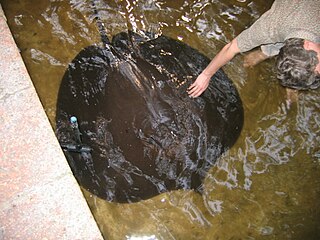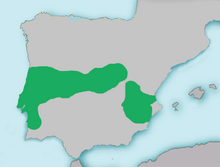
Lake Tanganyika is an African Great Lake. It is the second-oldest freshwater lake in the world, the second-largest by volume, and the second deepest, in all cases after Lake Baikal in Siberia. It is the world's longest freshwater lake. The lake is shared among four countries—Tanzania, the Democratic Republic of the Congo, Burundi, and Zambia—with Tanzania (46%) and the DRC (40%) possessing the majority of the lake. It drains into the Congo River system and ultimately into the Atlantic Ocean.

Stenodus leucichthys is a species of freshwater whitefish in the family Salmonidae. In the strict sense its natural distribution is restricted to the Caspian Sea basin. It is now considered extinct in the wild, but survives in cultured stocks. The nelma, a more widespread species of Eurasian and North America, is sometimes considered its subspecies.

The common rudd is a bentho-pelagic freshwater fish, widely spread in Europe and central Asia, around the basins of the North, Baltic, Black, Caspian and Aral seas.

River stingrays or freshwater stingrays are Neotropical freshwater fishes of the family Potamotrygonidae in the order Myliobatiformes, one of the four orders of batoids, cartilaginous fishes related to sharks. They are found in rivers in tropical and subtropical South America. A single marine genus, Styracura, of the tropical West Atlantic and East Pacific are also part of Potamotrygonidae. They are generally brownish, greyish or black, often with a mottled, speckled or spotted pattern, have disc widths ranging from 31 to 200 centimetres (1.0–6.6 ft) and venomous tail stingers. River stingrays feed on a wide range of smaller animals and the females give birth to live young. There are more than 35 species in five genera.

The New Zealand longfin eel, also known as ōrea, is a species of freshwater eel that is endemic to New Zealand. It is the largest freshwater eel in New Zealand and the only endemic species – the other eels found in New Zealand are the native shortfin eel, also found in Australia, and the naturally introduced Australian longfin eel. Longfin eels are long-lived, migrating to the Pacific Ocean near Tonga to breed at the end of their lives. They are good climbers as juveniles and so are found in streams and lakes a long way inland. An important traditional food source for Māori, who name them ōrea, longfin eel numbers are declining and they are classified as endangered, but over one hundred tonnes are still commercially fished each year.

The giant freshwater stingray is a species of stingray in the family Dasyatidae. It is found in large rivers and estuaries in Southeast Asia and Borneo, though historically it may have been more widely distributed in South and Southeast Asia. The widest freshwater fish and the largest stingray in the world, this species grows up to 2.2 m (7.2 ft) across and can reach up to 300 kg (660 lb) in weight. It has a relatively thin, oval pectoral fin disc that is widest anteriorly, and a sharply pointed snout with a protruding tip. Its tail is thin and whip-like, and lacks fin folds. This species is uniformly grayish brown above and white below; the underside of the pectoral and pelvic fins bear distinctive wide, dark bands on their posterior margins.

Anaecypris hispanica, the Spanish minnowcarp, is a small species of ray-finned fish species in the family Cyprinidae. It is the only living member of the genus Anaecypris. It is endemic to the Iberian Peninsula and is found in the basin of the Guadiana River in southern Spain and Portugal. Its natural habitats are rivers and intermittent rivers which are shallow, highly oxygenated, have a water temperature of no more than 25 °C and have a coarse stream bed. It is threatened by habitat loss. They grow to a maximum size of 60mm and live for three years.

The Northern straight-mouth nase is a species of ray-finned fish in the family Cyprinidae. It is found in Portugal and Spain. Its natural habitat is rivers. It is threatened by habitat loss.

Parachondrostoma turiense is a species of ray-finned fish in the family Cyprinidae. It is found only in Spain. Its natural habitat is rivers. It is threatened by habitat loss.

Pseudochondrostoma willkommii is a species of cyprinid fish, which is found in Portugal and Spain. Its natural habitats are rivers and water storage areas, and it is threatened by habitat loss.

Squalius carolitertii, the Northern Iberian chub, is a species of fresh-water fish in the family Cyprinidae. It is found in Portugal and Spain, and known there as the bordallo, escalo or gallego.
Telestes polylepis is a species of ray-finned fish in the family Cyprinidae. It is a freshwater fish. It is found only in a 100-metre stretch of a Croatian stream. Its natural habitat is rivers. It is threatened by new species of Pike being introduced to its stream as well as habitat loss. People think they may be extinct within the next few years as there are less than 80 left.
Stenodus nelma, known alternatively as the nelma, sheefish, siifish, inconnu or connie, is a commercial species of freshwater whitefish in the family Salmonidae. It is widespread in the Arctic rivers from the Kola Peninsula eastward across Siberia to the Anadyr River and also in the North American basins of the Yukon River and Mackenzie River.

The smallscale yellowfish is a South African species of freshwater fish in the cyprinid family. It is native to the Limpopo, Incomati and Pongolo drainages.

Achondrostoma arcasii, termed the bermejuela, is a species of freshwater fish in the family Cyprinidae. It is found in the Douro River in northern Portugal and in rivers draining to both the Atlantic Ocean and the Mediterranean, including the Ebro River, in northern Spain where it is threatened by loss of habitat caused by the building of canals and the construction of dams, as well as by introduced predators and water pollution.

The short-tailed river stingray is a species of river stingray native to the Río de la Plata Basin in South America. It is sometimes known as the giant freshwater stingray, but this name is typically used for the southeast Asian Urogymnus polylepis.

Pseudochondrostoma is a genus of cyprinid fish that occurs in the Iberian Peninsula.

Iberian gudgeon is a species of gudgeon, a small freshwater in the family Cyprinidae. It is widespread only in the Iberian Peninsula where it is indigenous in the Ebro and Bidasoa drainage, and in France in the Adour drainage, as well as Andorra. It has been introduced throughout the Iberian Peninsula, including Portugal, It is a freshwater demersal fish, up to 11.9 cm long.
Squalius malacitanus, commonly known as the Málaga chub, is a species of freshwater fish in the carp family Cyprinidae. It was first isolated from the Guadalmina River in Málaga, hence its name. It is considered a vulnerable species. S. malacitanus differs from its cogenerate species by having 7–8 branched rays in its dorsal fin, 8 branched rays in the anal lateral line; the number of scale rows above its lateral line; possessing 3 scale rows below its lateral line; 38 vertebrae, 21 abdominal, and 17 caudal; large fourth and fifth infraorbital bones; maxilla without a pointed anterior process; the middle of its frontal bone being narrow, as well as its neurocranium bone; the lower branch of its pharyngeal bone is rather long; and the shortness of the inferior lamina of its urohyal bone.
Iguanodectes polylepis is a species of freshwater fish from the rivers of South America. Its range is restricted to Brazil, where it inhabits the Madeira and Purus river basins. It is one of the larger members of the genus, but remains generally small, only a little over a quarter-foot long.


















